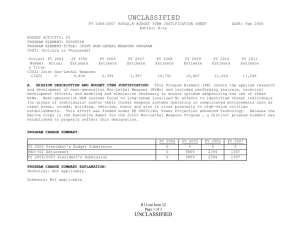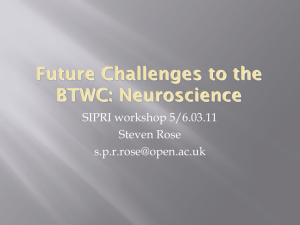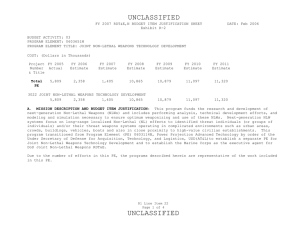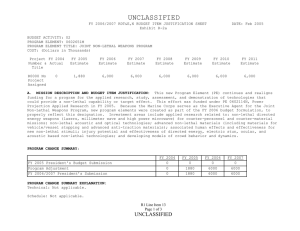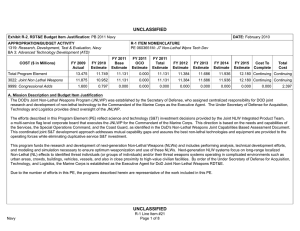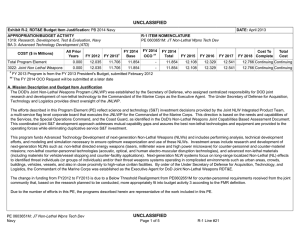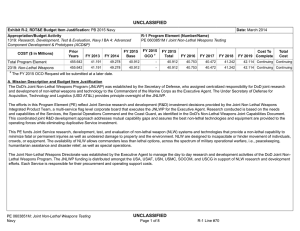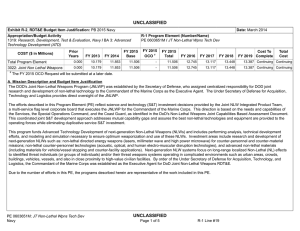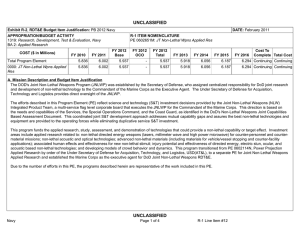UNCLASSIFIED
advertisement
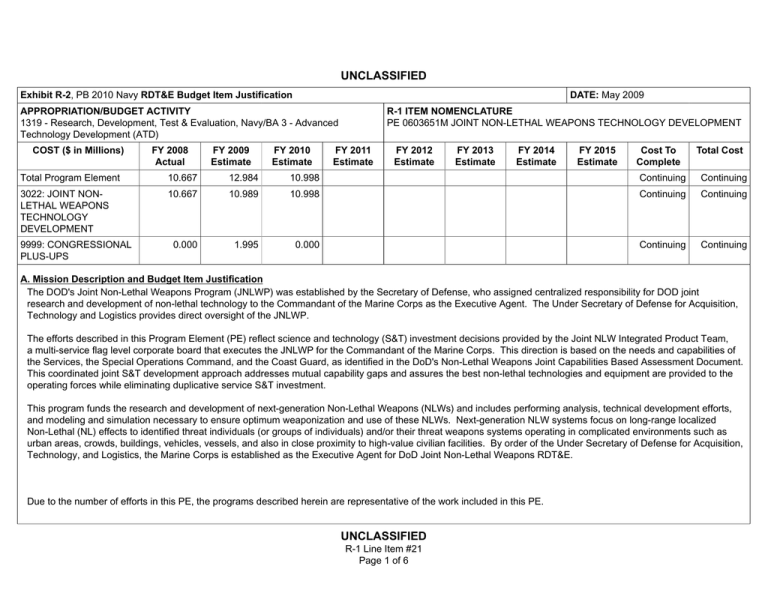
UNCLASSIFIED Exhibit R-2, PB 2010 Navy RDT&E Budget Item Justification DATE: May 2009 APPROPRIATION/BUDGET ACTIVITY 1319 - Research, Development, Test & Evaluation, Navy/BA 3 - Advanced Technology Development (ATD) COST ($ in Millions) FY 2008 Actual FY 2009 Estimate FY 2010 Estimate R-1 ITEM NOMENCLATURE PE 0603651M JOINT NON-LETHAL WEAPONS TECHNOLOGY DEVELOPMENT FY 2011 Estimate FY 2012 Estimate FY 2013 Estimate FY 2014 Estimate FY 2015 Estimate Cost To Complete Total Cost Total Program Element 10.667 12.984 10.998 Continuing Continuing 3022: JOINT NONLETHAL WEAPONS TECHNOLOGY DEVELOPMENT 10.667 10.989 10.998 Continuing Continuing 0.000 1.995 0.000 Continuing Continuing 9999: CONGRESSIONAL PLUS-UPS A. Mission Description and Budget Item Justification The DOD's Joint Non-Lethal Weapons Program (JNLWP) was established by the Secretary of Defense, who assigned centralized responsibility for DOD joint research and development of non-lethal technology to the Commandant of the Marine Corps as the Executive Agent. The Under Secretary of Defense for Acquisition, Technology and Logistics provides direct oversight of the JNLWP. The efforts described in this Program Element (PE) reflect science and technology (S&T) investment decisions provided by the Joint NLW Integrated Product Team, a multi-service flag level corporate board that executes the JNLWP for the Commandant of the Marine Corps. This direction is based on the needs and capabilities of the Services, the Special Operations Command, and the Coast Guard, as identified in the DoD's Non-Lethal Weapons Joint Capabilities Based Assessment Document. This coordinated joint S&T development approach addresses mutual capability gaps and assures the best non-lethal technologies and equipment are provided to the operating forces while eliminating duplicative service S&T investment. This program funds the research and development of next-generation Non-Lethal Weapons (NLWs) and includes performing analysis, technical development efforts, and modeling and simulation necessary to ensure optimum weaponization and use of these NLWs. Next-generation NLW systems focus on long-range localized Non-Lethal (NL) effects to identified threat individuals (or groups of individuals) and/or their threat weapons systems operating in complicated environments such as urban areas, crowds, buildings, vehicles, vessels, and also in close proximity to high-value civilian facilities. By order of the Under Secretary of Defense for Acquisition, Technology, and Logistics, the Marine Corps is established as the Executive Agent for DoD Joint Non-Lethal Weapons RDT&E. Due to the number of efforts in this PE, the programs described herein are representative of the work included in this PE. UNCLASSIFIED R-1 Line Item #21 Page 1 of 6 UNCLASSIFIED Exhibit R-2, PB 2010 Navy RDT&E Budget Item Justification APPROPRIATION/BUDGET ACTIVITY 1319 - Research, Development, Test & Evaluation, Navy/BA 3 - Advanced Technology Development (ATD) B. Program Change Summary ($ in Millions) Previous President's Budget Current BES/President's Budget Total Adjustments Congressional Program Reductions Congressional Rescissions Total Congressional Increases Total Reprogrammings SBIR/STTR Transfer Program Adjustments Rate/Misc Adjustments DATE: May 2009 R-1 ITEM NOMENCLATURE PE 0603651M JOINT NON-LETHAL WEAPONS TECHNOLOGY DEVELOPMENT FY 2008 10.736 10.667 -0.069 FY 2009 11.020 12.984 1.964 -0.035 FY 2010 11.167 10.998 -0.169 FY 2011 2.000 -0.069 -0.001 Congressional Increase Details ($ in Millions) -0.170 0.001 FY 2008 Project: 9999, EYE SAFE LASER WARNING SYSTEMS 0.000 Change Summary Explanation Technical: Not applicable. Schedule: Not applicable. UNCLASSIFIED R-1 Line Item #21 Page 2 of 6 FY 2009 1.995 UNCLASSIFIED Exhibit R-2a, PB 2010 Navy RDT&E Project Justification DATE: May 2009 APPROPRIATION/BUDGET ACTIVITY 1319 - Research, Development, Test & Evaluation, Navy/BA 3 Advanced Technology Development (ATD) COST ($ in Millions) 3022: JOINT NONLETHAL WEAPONS TECHNOLOGY DEVELOPMENT FY 2008 Actual 10.667 FY 2009 Estimate 10.989 FY 2010 Estimate R-1 ITEM NOMENCLATURE PE 0603651M JOINT NON-LETHAL WEAPONS TECHNOLOGY DEVELOPMENT FY 2011 Estimate FY 2012 Estimate FY 2013 Estimate FY 2014 Estimate FY 2015 Estimate 10.998 PROJECT NUMBER 3022 Cost To Complete Continuing Total Cost Continuing A. Mission Description and Budget Item Justification This project funds the research and development of next-generation NLWs and includes performing analysis, technical development efforts, and modeling and simulation necessary to ensure optimum weaponization and use of these NLWs. Investment areas include research and development of next-generation NLWs such as: non-lethal directed energy weapons (lasers, millimeter wave and high power microwave) for counter-personnel and counter-material missions; non-lethal counterpersonnel technologies (acoustic, optical, and human electro-muscular disruption technologies), and advanced non-lethal materials (including materials for vehicle/ vessel stopping and counter-facility applications). Next-generation NLW systems focus on long-range localized NL effects to identified threat individuals (or groups of individuals) and/or their threat weapons systems operating in complicated environments such as urban areas, crowds, buildings, vehicles, vessels, and also in close proximity to high-value civilian facilities. B. Accomplishments/Planned Program ($ in Millions) FY 2008 JOINT NON-LETHAL WEAPONS 10.667 FY 2008 Accomplishments: - Continued effort to assess the general utility, effect, and effectiveness of technologies for incapacitating personnel, clearing facilities, stopping vehicles and vessels, and denying enemy access to protected areas. - Continued design of a man-transportable laser weapons system that can be used for non-lethal counterpersonnel or non-lethal counter-materiel applications through ultra-high precision engagement of selected targets with minimal collateral damage. - Continued research to define the optimum approaches, technologies and tactics necessary to clear a facility/building with and without entry. - Continued characterization of bioeffects induced via acoustic non-lethal weapon concepts. - Continued modeling/research to develop an understanding of the complex relationships between individual, group and crowd dynamics in order to predict the macro effects of NLWs. Specifically, UNCLASSIFIED R-1 Line Item #21 Page 3 of 6 FY 2009 10.989 FY 2010 10.998 FY 2011 UNCLASSIFIED Exhibit R-2a, PB 2010 Navy RDT&E Project Justification APPROPRIATION/BUDGET ACTIVITY 1319 - Research, Development, Test & Evaluation, Navy/BA 3 Advanced Technology Development (ATD) DATE: May 2009 R-1 ITEM NOMENCLATURE PE 0603651M JOINT NON-LETHAL WEAPONS TECHNOLOGY DEVELOPMENT B. Accomplishments/Planned Program ($ in Millions) FY 2008 investigate factors that cause crowds to move to violent behavior, and what non-lethal technologies will be effective in controlling or mitigating violent crowd behavior. - Continued effort to examine and optimize non-lethal effects and effectiveness of various non-lethal stimuli, to include light, acoustics, electrical, high power laser, high power microwave and active denial technology. Research includes human effects analysis with respect to existing non-lethal stimuli and other emerging system stimuli to characterize behaviors and their operational relevance. - Initiated prototype development and demonstration of the most promising candidate technologies addressing the vehicle/vessel stopping capability gap. - Initiated non-lethal effects characterization through modeling and effects testing using the Advanced Total Body Model. - Initiated prototype development and demonstration of the most promising directed energy technologies under consideration for counter-personnel and counter-materiel applications. - Initiated prototype development and demonstration of the most promising candidate technologies employing multi-sensory stimuli. - Initiated investigations of technology advancements to miniaturize proven non-lethal weapon prototypes /demonstrators to enable their transition to tactically relevant, cost effective capabilities in the field. FY 2009 Plans: - Continue all efforts from FY 2008. - Complete demonstration and transition of the most effective vehicle/vessel stopping technologies to acquisition programs. - Complete demonstration and transition of the most effective directed energy technologies with counterpersonnel and counter-materiel applications to higher categories of development/acquisition. - Initiate prototype development of advanced payloads for candidate technological capabilities with applications relevant to emerging capability gaps. - Initiate prototype development and demonstration of the most promising candidate technologies addressing the extended range/duration incapacitation capability gap. UNCLASSIFIED R-1 Line Item #21 Page 4 of 6 FY 2009 PROJECT NUMBER 3022 FY 2010 FY 2011 UNCLASSIFIED Exhibit R-2a, PB 2010 Navy RDT&E Project Justification DATE: May 2009 APPROPRIATION/BUDGET ACTIVITY 1319 - Research, Development, Test & Evaluation, Navy/BA 3 Advanced Technology Development (ATD) R-1 ITEM NOMENCLATURE PE 0603651M JOINT NON-LETHAL WEAPONS TECHNOLOGY DEVELOPMENT B. Accomplishments/Planned Program ($ in Millions) FY 2008 FY 2009 PROJECT NUMBER 3022 FY 2010 FY 2011 Cost To Complete Continuing Total Cost Continuing FY 2010 Plans: - Continue all efforts from FY 2009, less those noted as completed above. - Complete characterization of bioeffects induced via acoustic non-lethal weapon concepts. - Initiate transition to higher levels of development and demonstration for the most promising candidate technologies employing multi-sensory stimuli. C. Other Program Funding Summary ($ in Millions) PE 0602651M/Joint NonLethal Weapons Applied Research FY 2008 FY 2009 FY 2010 FY 2011 FY 2012 FY 2013 FY 2014 FY 2015 D. Acquisition Strategy Not applicable. E. Performance Metrics The primary objective of this Program Element is the development of technologies that lead to the next-generation of Non-Lethal Weapons which address identified and prioritized joint NLW capability gaps. The program consists of a collection of projects for the development and evaluation of feasibility demonstration models. Individual project metrics reflect the technical goals of each specific project. Typical metrics include both the effectiveness of the technology, human effects and effectiveness, mitigation of high priority joint NLW capability gaps, and potential for compliance with policy and legislation. Overarching considerations include the advancement of related Technology Readiness Levels and Human Effects Readiness Levels, the degree to which project investments are leveraged with other performers, reduction in life cycle cost upon application of the technology, and the identification of opportunities to transition technology to higher categories of development. UNCLASSIFIED R-1 Line Item #21 Page 5 of 6 UNCLASSIFIED Exhibit R-2a, PB 2010 Navy RDT&E Project Justification DATE: May 2009 APPROPRIATION/BUDGET ACTIVITY 1319 - Research, Development, Test & Evaluation, Navy/BA 3 Advanced Technology Development (ATD) COST ($ in Millions) 9999: CONGRESSIONAL PLUS-UPS FY 2008 Actual 0.000 FY 2009 Estimate 1.995 R-1 ITEM NOMENCLATURE PE 0603651M JOINT NON-LETHAL WEAPONS TECHNOLOGY DEVELOPMENT FY 2010 Estimate FY 2011 Estimate FY 2012 Estimate 0.000 FY 2013 Estimate FY 2014 Estimate FY 2015 Estimate PROJECT NUMBER 9999 Cost To Complete Continuing A. Mission Description and Budget Item Justification N/A C. Other Program Funding Summary ($ in Millions) N/A D. Acquisition Strategy N/A E. Performance Metrics N/A UNCLASSIFIED R-1 Line Item #21 Page 6 of 6 Total Cost Continuing
